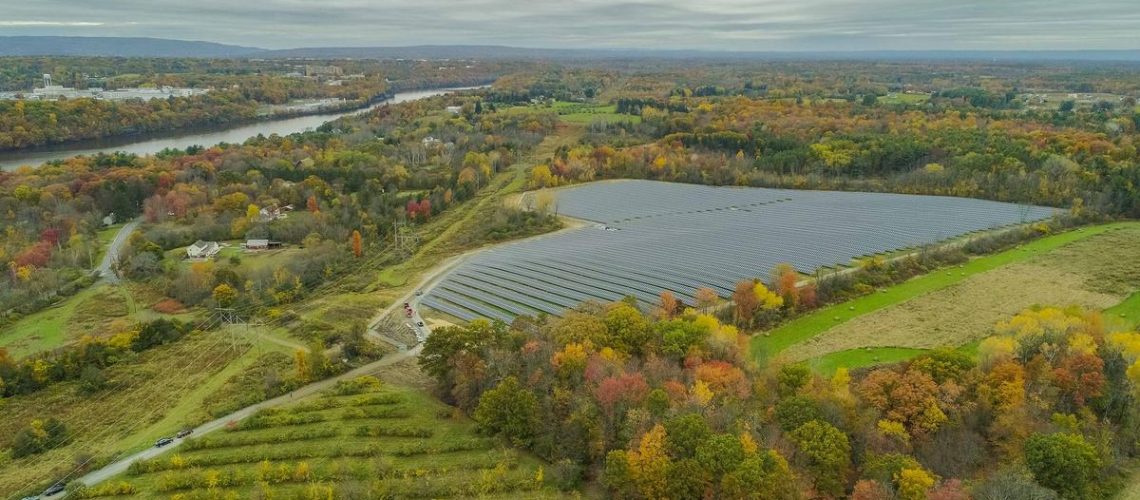This past week the State of New York passed a law in its 2024 budget that gives the New York Power Authority (NYPA), the state’s largest power authority, the ability to build renewable energy projects to help reach the state’s 2030 climate goals.
The Build Public Renewables Act is the result of about four years of clean energy policy initiatives and looks to solidify the Empire State as not just a leader in community solar deployments but also broader categories like offshore wind and standalone energy storage.
BPRA directs NYPA to plan, construct, and operate renewable energy projects in service of the state’s renewable energy goals, essentially giving the authority more power over clean energy directives than the previous 2019 Climate Leadership and Community Protection Act, which set greenhouse gas reduction goals of 70% for its power fleet to come from renewable energy while cutting greenhouse gas emissions by 40% by 2030.
The new law includes several provisions that provide community solar access to low- and middle-income residents (LMI), as well as codified labor and energy justice provisions for workers displaced by fossil fuel projects.
BRPA requires NYPA to establish a LMI program allowing disadvantaged residents to receive credit on their monthly electric bils for renewable energy produced by the power authority.
In the labor category, the new law requires that workers or contractors hired for construction of clean energy projects be protected by a collective bargaining agreement framework. Under BRPA, employers must sign a memorandum of understanding with labor unions to uphold and protect fair pay rates, provide training and safety protocols for workers on such projects.
The new law provides priority to job candidates who previously worked in oil and gas industry roles, and provides a job training framework for retaining clean energy jobs. Starting in 2024, NYPA will begin to invest $25 million per year in workforce training programs for the renewables sector.
Another bold piece of the BPRA law is a bullet point calling for the removal of simple-cycle natural gas power plants, or peakers, in NYPA’s jurisdiction by 2030. The law requires that peakers be replaced with dispatchable clean energy projects such as energy storage, removing a source of daily air pollution that has been cited for health conditions such as asthma in and near urban environments.
BPRA was written in 2021 and failed to pass into state law for the past two legislative sessions. Assembly Member Sarahana Shrestha (D-Kingston) has been instrumental in pushing the clean energy policy through the assembly. According to Shrestha’s website, before serving in the assembly, the Nepali-American official was part of the Public Power NY Coalition, and held public events in support of the BPRA.
BPRA is codified as Assembly Bill A1466D and was sponsored by assembly members Robert Carroll (District 44 – Brooklyn), William Colton (District 47–Brooklyn), Jeffrey Dinowitz (District 81–Bronx) and Richard Gottfried (District 75–Manhattan).
According to the New York Research Development Authority (NYSERDA), the state’s energy development authority, through February 28, 2023 the state had 4.58 GW of solar deployments across 193,529 total projects. The state enjoys a $1.98 per watt cost to install solar, an increase from $1.81/W in 2022, according to the NY Solar Map.
Industry reactions
The public power bill passed despite opposition from state and national trade groups Independent Power Producers of New York, the Alliance for Clean Energy New York (ACE-NY), and the Solar Energy Industries Association, among others.
In a joint letter to N.Y. Governor Kathy Hochul, six trade groups that include the ACE NY and SEIA said giving NYPA such authority “does not create a level playing field with the private sector.” They also raised concerns that the law does not address issues related to grid interconnection, upgrading power transmission systems or permitting processes.
“To meet its renewable energy mandates, we need the private sector to remain acutely interested in New York and aggressively develop, invest in, and build wind, solar, and battery storage energy projects. Our fear is that, if N.Y. state signals that it prefers that NYPA build the needed renewable energy and storage, the private sector will decide it is preferable to engage in the development process outside of N.Y.,” said the joint trade group.
ACE-NY members include national developers Cypress Creek Renewables, Avangrid, Invenergy and EDF Renewables North America.
Russell Wilcox, founder and chief executive officer of Urban Energy, a Brooklyn, N.Y.-based rooftop solar canopy and storage installer, said: “The only way this will be a successful program is if they allow private companies to lease rooftops and provide clean energy in an open market without labor provisions. Increasing the cost of labor in rooftop solar beyond the competitive market will make these projects impossible to be competitive on an institutional finance level.”
“Unless New York State is willing to provide extremely low interest rate debt and tax equity financing, projects like this cannot afford the increased cost of labor and regulation. Companies like Urban Energy provide a living wage for all in-house laborers and provide a inclusive platform for great, high paying jobs. If we need to provide labor with prevailing wages, it will significantly slow deployment and make it impossible to meet the goals of the act,” Wilcox told pv magazine USA.



